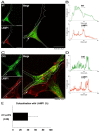The Infantile Leukoencephalopathy-Associated Mutation of C11ORF73/HIKESHI Proteins Generates de novo Interactive Activity with Filamin A, Inhibiting Oligodendroglial Cell Morphological Differentiation
- PMID: 33535532
- PMCID: PMC7912763
- DOI: 10.3390/medicines8020009
The Infantile Leukoencephalopathy-Associated Mutation of C11ORF73/HIKESHI Proteins Generates de novo Interactive Activity with Filamin A, Inhibiting Oligodendroglial Cell Morphological Differentiation
Abstract
Genetic hypomyelinating diseases are a heterogeneous group of disorders involving the white matter. One infantile hypomyelinating leukoencephalopathy is associated with the homozygous variant (Cys4-to-Ser (C4S)) of the c11orf73 gene. Methods: We observed that in mouse oligodendroglial FBD-102b cells, the C4S mutant proteins but not the wild type ones of C11orf73 are microscopically localized in the lysosome. And, they downregulate lysosome-related signaling in an immunoblotting technique. Results: The C4S mutant proteins specifically interact with Filamin A, which is known to anchor transmembrane proteins to the actin cytoskeleton; the C4S mutant proteins and Filamin A are also observed in the lysosome fraction. While parental FBD-102b cells and cells harboring the wild type constructs exhibit morphological differentiation, cells harboring C4S mutant constructs do not. It may be that morphological differentiation is inhibited because expression of these C4S mutant proteins leads to defects in the actin cytoskeletal network involving Filamin A. Conclusions: The findings that leukoencephalopathy-associated C11ORF73 mutant proteins specifically interact with Filamin A, are localized in the lysosome, and inhibit morphological differentiation shed light on the molecular and cellular pathological mechanisms that underlie infantile hypomyelinating leukoencephalopathy.
Keywords: C11orf73; Filamin A; HLD13; leukoencephalopathy; oligodendrocyte differentiation.
Conflict of interest statement
The authors have declared that no competing interests exist.
Figures










Similar articles
-
Hypomyelinating Leukodystrophy 8 (HLD8)-Associated Mutation of POLR3B Leads to Defective Oligodendroglial Morphological Differentiation Whose Effect Is Reversed by Ibuprofen.Neurol Int. 2022 Feb 16;14(1):212-244. doi: 10.3390/neurolint14010018. Neurol Int. 2022. PMID: 35225888 Free PMC article.
-
Hypomyelinating Leukodystrophy 7 (HLD7)-Associated Mutation of POLR3A Is Related to Defective Oligodendroglial Cell Differentiation, Which Is Ameliorated by Ibuprofen.Neurol Int. 2021 Dec 22;14(1):11-33. doi: 10.3390/neurolint14010002. Neurol Int. 2021. PMID: 35076634 Free PMC article.
-
Hypomyelinating leukodystrophy-associated mutation of RARS leads it to the lysosome, inhibiting oligodendroglial morphological differentiation.Biochem Biophys Rep. 2019 Nov 7;20:100705. doi: 10.1016/j.bbrep.2019.100705. eCollection 2019 Dec. Biochem Biophys Rep. 2019. PMID: 31737794 Free PMC article.
-
Involvement of filamin A and filamin A-interacting protein (FILIP) in controlling the start and cell shape of radially migrating cortical neurons.Anat Sci Int. 2005 Mar;80(1):19-29. doi: 10.1111/j.1447-073x.2005.00101.x. Anat Sci Int. 2005. PMID: 15794127 Review.
-
Mechanical response of single filamin A (ABP-280) molecules and its role in the actin cytoskeleton.J Muscle Res Cell Motil. 2002;23(5-6):525-34. doi: 10.1023/a:1023418725001. J Muscle Res Cell Motil. 2002. PMID: 12785102 Review.
Cited by
-
Hypomyelinating Leukodystrophy 8 (HLD8)-Associated Mutation of POLR3B Leads to Defective Oligodendroglial Morphological Differentiation Whose Effect Is Reversed by Ibuprofen.Neurol Int. 2022 Feb 16;14(1):212-244. doi: 10.3390/neurolint14010018. Neurol Int. 2022. PMID: 35225888 Free PMC article.
-
A Novel Pathogenic Variant Identified in HIKESHI-Related Hypomyelinating Leukodystrophy Disrupts Heat Shock Response in iPSCs.Int J Mol Sci. 2025 Jun 24;26(13):6037. doi: 10.3390/ijms26136037. Int J Mol Sci. 2025. PMID: 40649816 Free PMC article.
-
Hypomyelinating Leukodystrophy 15 (HLD15)-Associated Mutation of EPRS1 Leads to Its Polymeric Aggregation in Rab7-Positive Vesicle Structures, Inhibiting Oligodendroglial Cell Morphological Differentiation.Polymers (Basel). 2021 Mar 29;13(7):1074. doi: 10.3390/polym13071074. Polymers (Basel). 2021. PMID: 33805425 Free PMC article.
-
Hypomyelinating Leukodystrophy 7 (HLD7)-Associated Mutation of POLR3A Is Related to Defective Oligodendroglial Cell Differentiation, Which Is Ameliorated by Ibuprofen.Neurol Int. 2021 Dec 22;14(1):11-33. doi: 10.3390/neurolint14010002. Neurol Int. 2021. PMID: 35076634 Free PMC article.
-
Defective oligodendrocyte differentiation by hypomyelinating leukodystrophy 13 (HLD13)-associated mutation of Hikeshi.Mol Genet Metab Rep. 2023 Oct 27;37:101017. doi: 10.1016/j.ymgmr.2023.101017. eCollection 2023 Dec. Mol Genet Metab Rep. 2023. PMID: 37965292 Free PMC article. No abstract available.
References
LinkOut - more resources
Full Text Sources
Other Literature Sources

